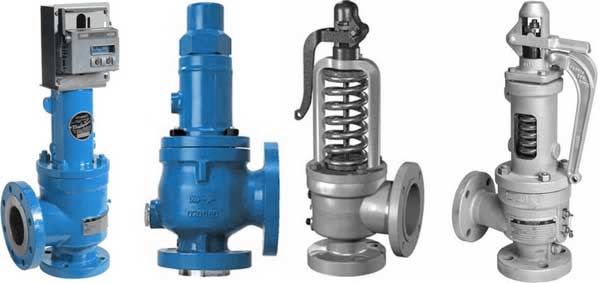 |
Pressure Reducing Valve
|
Pressure Reducing Valve (PRV), Pressure Relief Valve (PRV) and Pressure Safety Valve (PSV), each have different functions, but are often confused by some people. If you look at the abbreviations, that is not really surprising.
Pressure Reducing Valve (PRV)
In hydraulics, a pressure reducing valve serves the same purpose as a 'pressure regulator' valve in a compressed air system. It can be described as a 2-way, normally open valve controlled from its own outlet.
It is one of many pressure control valves available for hydraulic circuits. It is always used in a branch line, never in the entire supply line of the pump. It reduces the pressure in one branch while other branches can operate at full system pressure.
A knob or screw can be used to adjust the outlet pressure over the working range of the valve. The valve accepts a flow of high-pressure oil at the inlet and delivers the same flow at the outlet with a constant reduced pressure, as long as the inlet pressure exceeds the value set on the adjustment knob.

Pressure Relief Valve (PRV)
A pressure relief valve (PRV) is a type of valve used to release liquits in various equipment to maintain optimum pressure levels. PRVs open gradually as pressure increases to release the required amount of pressure. Although the term PRV is sometimes used interchangeably with PSV, there is a difference between the two.
A PRV opens gradually in relation to the pressure, while a PSV opens suddenly once the pressure reaches a certain level to prevent overpressure and a potential process safety incident.
PRVs are designed to protect pressure-sensitive systems and equipment from the damaging effects of overpressure.
PRVs are often used in liquid systems, where gradual pressure relief is required.

Pressure Safety Valve (PSV)
A Pressure Safety Valve (PSV) is a type of valve used to rapidly release fluids from equipment to prevent overpressure and possible process safety incidents. A PSV is automatically activated when pressure exceeds prescribed pressure limits to return the pressure in the equipment to a safe operating level.
PSVs are the ultimate safety devices to protect people, property and processes from major damage. It is a safety device that can always operate and is the last resort to prevent catastrophic failure in systems under overpressure.
PSVs are often used in gas or steam systems, where it is crucial to release pressure quickly.

So beware of the abbreviation PRV for two quite different valves.
Related Post(s)

A pressure Relief Valve is a safety device designed to protect a pressurized vessel or system during an overpressure event...